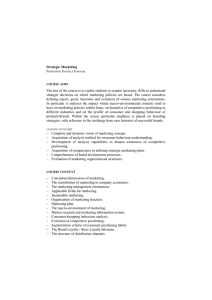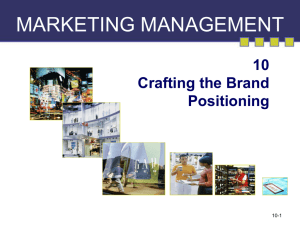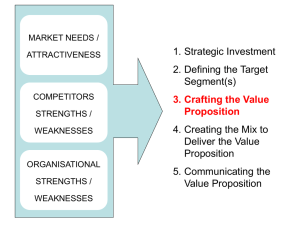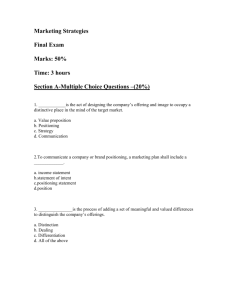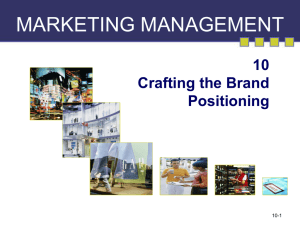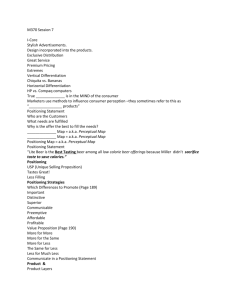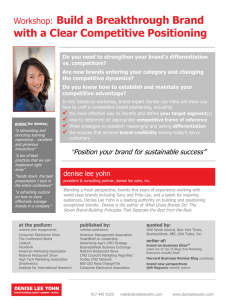Marketing for Entrepreneurs 1
advertisement
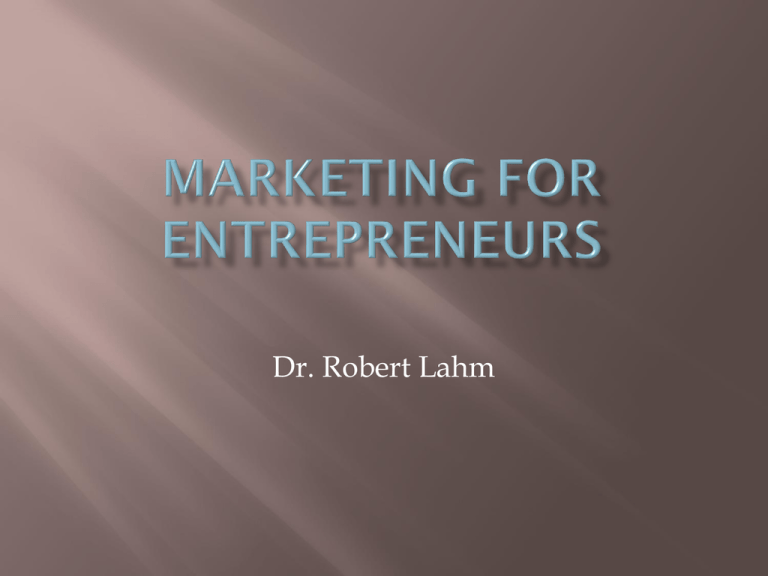
Dr. Robert Lahm Needs and Wants Marketing is based on “needs” and “wants” Some basic needs include food, clothing, and shelter – but is that all there is to it? No. Let’s take clothing for example – you are all wearing brands. What are the brands you are wearing? More importantly (for marketers), why did you select those brands? Was it the “look” (to be stylish), or the features (pockets, Velcro), or the price, or some other reason (utilitarian – keeps you cool or warm relative to the weather)? Needs and Wants Wants distinguish specific attributes of a product or service. We mentioned food. Do you want just any food? “You can live on it”: bread, rice, pork (but some cultures prohibit certain foods). Describe your ideal meal. Is it fast to prepare? Is it prepared for you? How much does it cost? Is it quick? Does it really matter all that much, if you are health conscious, and watching your diet? What are the diet plan commercials really selling (regaining your looks)? Story about “just put the food in the bag” (I don’t care to taste it). Without purchasing power (the ability to actually buy) a “want” never becomes a demand. You may want a Mercedes. Everyone in this room may want one, too. But, market “demand” can only occur if a sufficient number of customers – with the ability to pay – and the willingness to do so, exists. (Story about “qualifying” customers for real estate; 4SaleByWeb.com) One overly enterprising “entrepreneur,” a glass window installer, was recently in the news. He created demand. How? By cruising the streets and breaking out the storefront windows of prospects. He would even call them from nearby, using his cell phone, and let them know that they could have their broken glass replaced. (He’s now in trouble with the law). A product (synonymous with service in this discussion thus far) presents a “solution” that may in fact (or may claim to) satisfy a need or want. If enough customers have the ability and willingness to purchase the “solution” that a product or service offers, then it can be said that there is demand. In one sense, a product is a “bundle of benefits” (if you are developing yours effectively). Entrepreneurial Marketing must start with identifying problems, and creating solutions. Simple, right? No – not so fast! I have a solution for all those individuals who want that Mercedes: jogging shoes. They’re cheaper than a Mercedes, better for you healthwise, fashionable, comfortable, and they’ll get you where you are going. Why do you not like my solution? What’s so great about a car? It only takes you from “point A to point B,” just like the shoes. (Discussion about benefits of cars, generally, and Mercedes cars, specifically.) Products and services are typically “sized-up” by consumers as they consider whether or not their needs and wants might be satisfied, and how well. In choosing an automobile, what is are the most important considerations for you? Let’s try some basic features (and benefits): Speed, gas mileage, number of doors, reliability, cost of ownership (list as many as you can). I’d like to sell you a soft drink. The problem is, I really don’t have a container for you. Can’t you just drink it (and not gripe)? What’s so important about that package? Why do we want to buy a product “new in a factory sealed box”? What comes in the box? Product offerings typically involve physical goods themselves, services delivered with those goods, and “ideas.” At a restaurant, the entrepreneur may sell: “goods” (burgers and fries); “services” (a place to eat, food is cooked for you); And the “idea.” What’s the “idea” at a fast food restaurant” (Duh – speed!) What about Cracker Barrel? What about the “Heart Attack Grill?” Customers expect a level of product and performance that is consistent with explicit and implicit propositions conveyed through product claims. For instance, what do you expect from any copy machine? The “delight” factor may be created by unexpected (or understated) acts of superior – differentiated – service. With a car, for example, including a manual, mats, touch-up paint, a spare key, a road map, and a picnic basket (with a coupon for a “to go” meal) would be an excellent way for a car retailer to provide “extras” by throwing them in (most dealers are too short-sighted to do this). Many times, a customer or client may state a need, but may actually be “wanting” a solution. Home Depot sells drills, in many sizes and configurations. When a customer visits the store, the stated need may be, “I’m looking for a drill.” What is the real need? The business that offers the best solution, considering many factors is the best company (in some cases, that may even include a referral to another business that can do a better job in meeting a customer’s needs). Al Ries and Jack Trout wrote the marketing classic, Positioning - The Battle for Your Mind (a good summary, here) Information overload was a key premise of the authors’ work. Brands must cut through the mental clutter to attain a unique “position,” in the mind of the consumer: “Positioning is not what you do to a product. Positioning is what you do to the mind of the prospect. That is, you position the product in the mind of the prospect.” Strategies for positioning: Strengthen an existing brand; While Hertz was thought of as the world’s largest car rental agency, Avis cleverly took a different (and unique) position: “We’re number two, we try harder.” Search for and claim a new and unoccupied position: light beer, lemon dish soap, gold, platinum, or titanium credit cards, (food that’s very, very bad for you!). Hint: try the game of “opposites.” Hint #2: Focus on a core strength, such as fastest, cheapest, most expensive, exclusive (e.g., members only), reliable (guaranteed for life is the brand positioning of Craftsman tools from Sears), friendliest service. Marlboro was originally a “woman’s cigarette” (“Mild as May”) Stolichnaya Vodka repositioned other brands, such as Smirnoff and Wolfschmidt, by highlighting their origins in the U.S. and using an authenticity appeal for its own brand: “Stolichnaya is different. It is Russian.” Wendy’s attacked consumers’ perceptions about other bigger hamburger chains with one of the most famous commercials of all time: “Where’s the beef?” Charmin positioned its brand as being “Squeezably soft!” FedEx changed the entire shipping business with a reliability and speed promise: “When it absolutely, positively has to be there overnight.”
